Teaching activity planned by Ettore Bronzini, Fabrizio Gentile, Greta Toni, and Massimiliano Matteuzzi during the PhD course “Designing innovative public engagement activities”, held at the University of Bologna in 2023.
Brief description of the activity:
Galaxies, such as many other celestial objects, appear different according to the instrument used to observe them. In this activity, we will fabrics of different texture and music, so as to represent the various components of one of them, thus making a personal galaxy-pin.
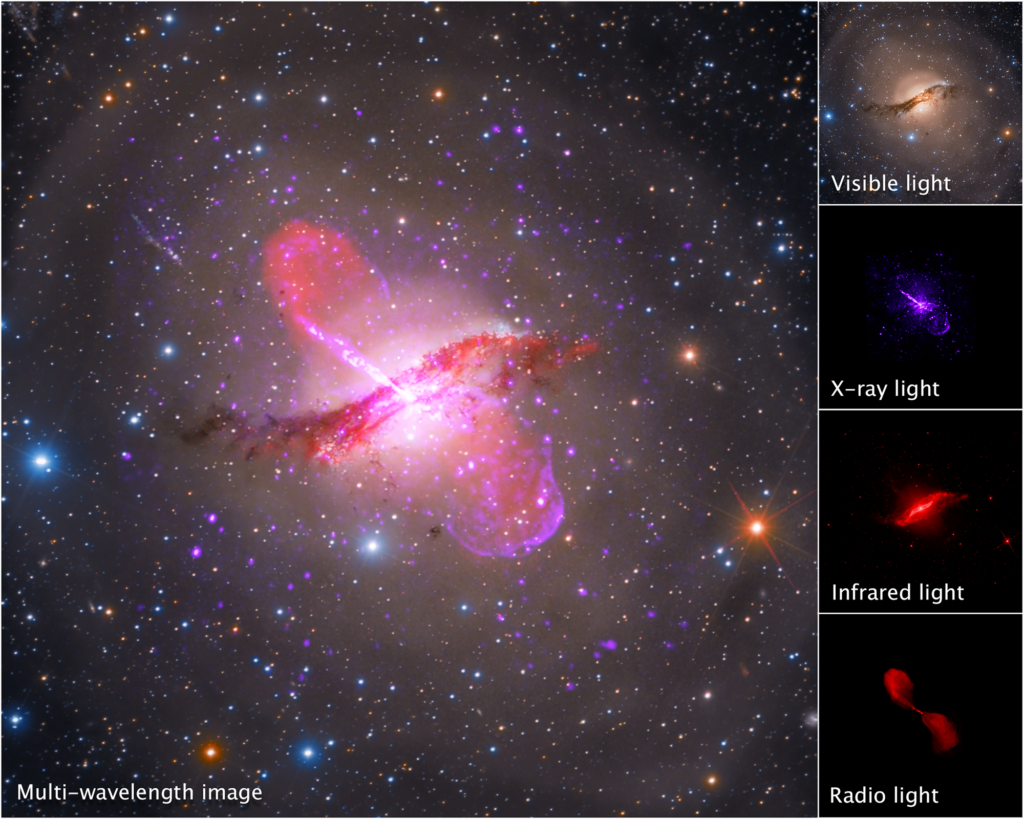
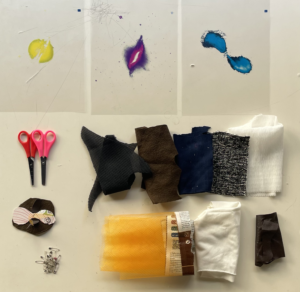
Materials
- Printouts of the Centaurus A Galaxy in different wavelenghts (if possible on a transparency, download available here: optical, infrared, radio)
- Fabrics of different texture (recycled materials)
- Stapler
- Scissors
- Safety pins
- Prototypes of galaxy-brooches as examples
- 4 audio tracks (download availabile here: 1, 2, 3, 4)
- Speaker for the reproduction of audio tracks
Preparing the activity
Arrange the material on the table, so that it is tidy and easily accessible.
The minimum recommended age for taking part in the activity is 8 years of age.
Description of the activity
1. Start the activity by showing a prototype of the galaxy-brooch, and discussing together on the shape, roughness and type of material used to represent the four components (optical, infrared, radio, X). In order to encourage discussion, you can ask questions, such as “What does this object look like to you? What shape does it have? What do you think it is?”
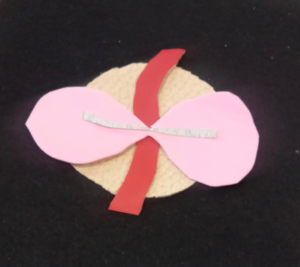
2. Show the images printed on transparency, overlapping one onto another so as to reconstruct the Centaurus A galaxy. Each image represents a particular component of the galaxy, which can be observed by using different instruments.
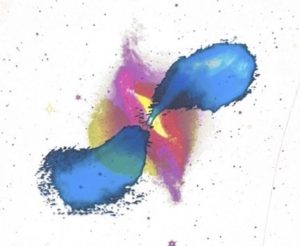
3. Start the construction of the galaxy-pin starting from the optical, i.e. the basic disk. Ask pupils to choose a soft, but also rigid enough fabric, (color does not matter) and cut out a circle to represent the optical component, mainly made of stars.
Show the image corresponding to the optical component, noting that there is an area of the galaxy obscured, from which no visible light comes. The phenomenon is caused to the presence of dust, which blocks the light of the stars behind it.
Suggestion: in the various stages of construction, participants might want to perfect their galaxy-brooch and start again and again thus, extending the duration of the activity. It is preferable to try to maintain the stage of realization of each component within 5 minutes. It is nice to be motivated to improve your own work, but you can recall that there are different components to explore and that their model cannot be wrong: there are so many galaxies in the Universe that surely there will be one that looks like it!

4. Let the pupils listen to the audio track 1, which consists in the reproduction of a song, using a piano only. Discuss briefly together, asking questions such as: “Which tools can you make out? Do you think have you ever heard this song?”
5. Proceed by adding the infrared component. This light is mainly produced by the same light blocking the visible radiation. In order to represent this structure, cut out an “S”-shaped fabric in faux leather and overlap it onto the al circle you have prepared beforehand.
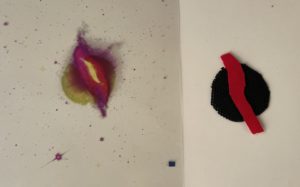
6. Let the pupils listen to the audio track 2 , which contains the same song of the preceding audio track, but using only the electric guitar. Discuss briefly, as for point 4.
7. Choose a fabric with a very low surface roughness, smooth to the touch, for the radio component, and cut out a 8-shape to represent the radio component. This is the emission produced by a very peculiar object placed at the centre of the Centaurus A galaxy: a supermassive black hole. Overlap the new shape onto the others, as shown in figure.
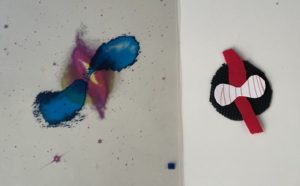
8. Reproduce the audio track 3, which uses a base and a violin. Discuss it briefly, as in point 4.
9. Add the last component to the model, namely X rays, also produced by the black hole. Choose a very rough fabric and cut out a thin strip. Overlap into the others, as you can see in the figure.
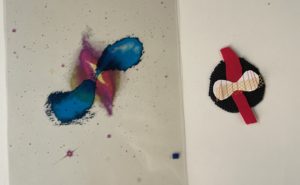
10. The model is complete: fix the various components with a stapler and add a safety pin. Proceed listening to the audio track 4, which contains all the instruments used sofar, just like every galaxy-brooch is now formed by all the main components it is made of.
Explanation of the physical process
The light we can see with our own eyes (visible light) is only one of many types of light, defined as electromagnetic waves. In the universe, celestial bodies do not emit only visible light, but also many other kinds of electromagnetic waves, invisible to us. For example, a single galaxy can appear very different when observed with instruments observing different electromagnetic spectrum bands (the set of all electromagnetic waves). In particular, some kinds of galaxies, called radio-galaxies, because of a black hole at their centre, emit radiation from the radio band to X-rays.
Each instrument, and therefore each band of the electromagnetic spectrum gives us information on a different component of this galaxy and on the various physical processes which generate the emission.
In this activity, we have chosen to analyze a well-known example of radio-galaxy, called Centaurus A. We can sum up the different emissions and components of this galaxy while talking of four different regions of the electromagnetic spectrum: i.e. visible light (or optical band), infrared light, radio waves and X rays.
The optical (or visible) band
In the optical image there are both isolated and bright stars (namely belonging to our galaxy, the Milky Way), as well as stars belonging to the Centaurus A Galaxy, which are farther away from us in comparison with the Milky Way stars.
Seen in the visible band (namely, in the region of the spectrum to which our eyes are sensitive), the light of Centaurus A is produced by the multitude of stars that it contains. We cannot distinguish the stars one by one, but we observe the light they radiate in this round-shaped glow. Because of its shape in the optical band, this galaxy is classified as elliptical.
By observing this galaxy in the optical, we notice that, over and above starlight, there is a central structure, which looks like a belt. We call this material dust: it obscures the region behind, i.e. does not allow the observation from the ground.
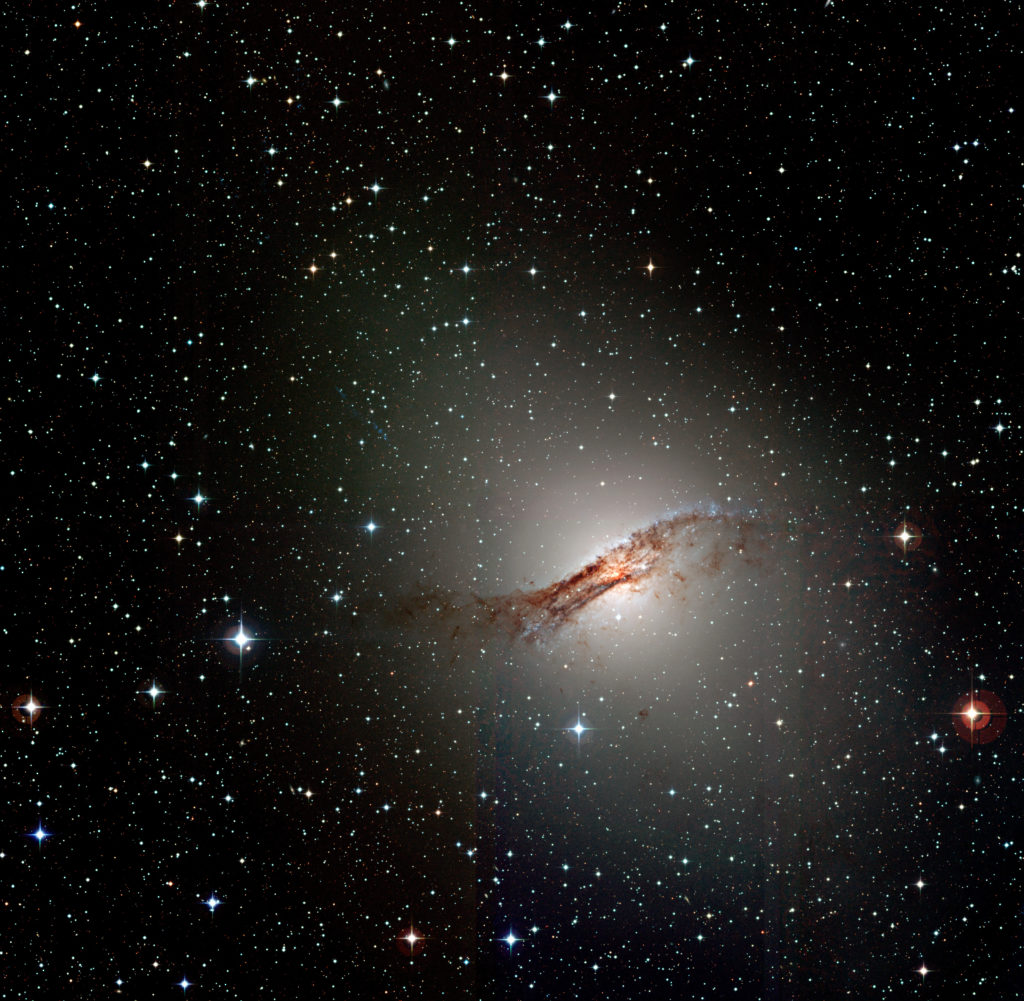
The infrared band
Here is once again the same galaxy, seen from a different wavelength. This time, we are looking at it in the infrared. What do you notice that is different? Does it look the same galaxy as before? Actually no, it looks like a different galaxy. In this new wavelenght, stars are so weak that they are invisible, whereas dust can issue abundant radiation (notice, indeed that the now “visible” part has the same shape of the dust belt which, in the optical, obscured the stars). This happens because the type of emission produced by an object strongly depends on its temperature. Very hot stars (with temperatures of thousands of degrees) emit in the “visible” light, whereas dust, which is much cooler (hundreds of degrees below zero) emits in the infrared. Equivalent objects to understand this concept may be incandescent light bulbs (which are very hot; indeed, we see their light with our own eyes, and the human body (which is much cooler, inasmuch as we see its “light” with infrared thermometers). Therefore, the study of this new band allows us to better catch the structure of dust without being disturbed by the light of the stars.
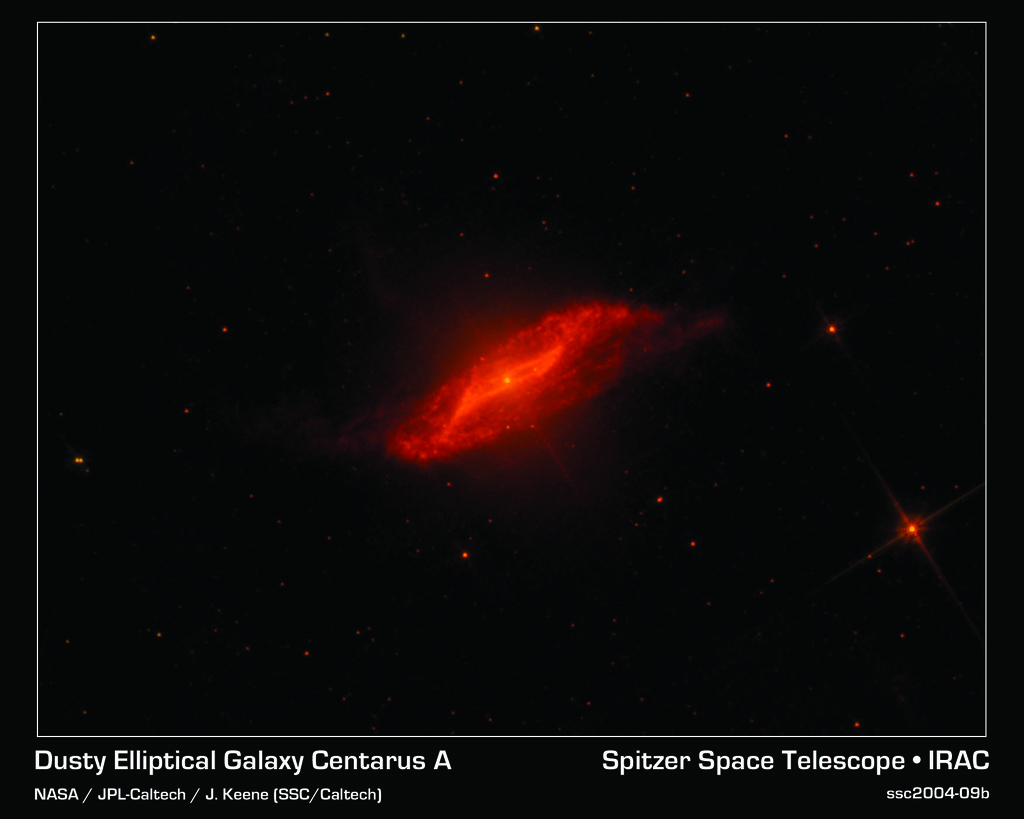
The radio band
A the centre of each massive galaxy there is a black hole with a mass of millions or bilions times the mass of our Sun, whence the name – super-massive black holes. Some of them can produce powerful plasma jets, a particular kind of material made of electrons and other sub-atomic particles. Because of the presence of magnetic fields inside the galaxy, these particles are forced to move along elliptical trajectories, while emitting a radiation which assumes an “8” shape. This peculiar radiation is called synchrotron radiation and can be observed mainly in the radio and X band.
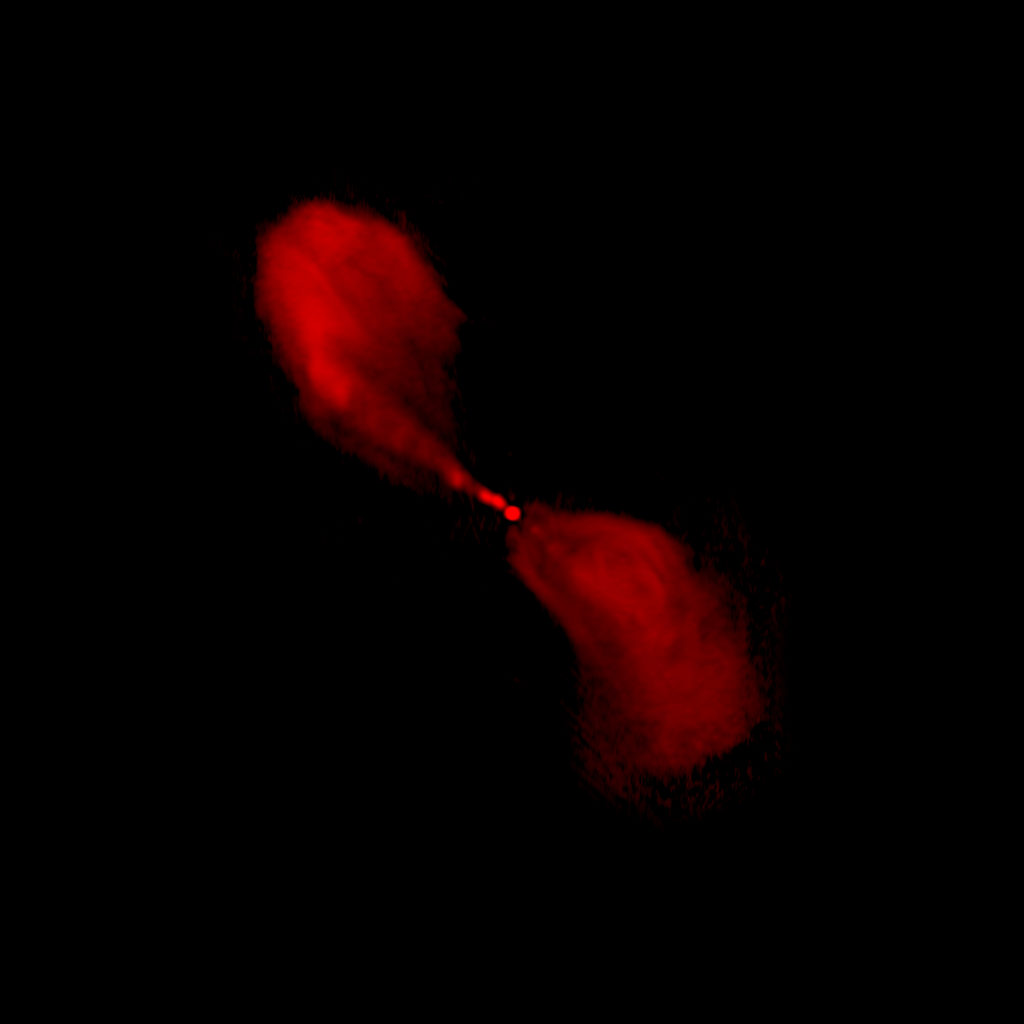
The X band
As explained above, synchrotron radiation is emitted from the radio band up to the X-band. Unlike the radio band, however, in the X band there is another significant effect: the plasma emitted by the black hole, interacting with the gas found inside the galaxy, heats it up to temperatures of tens of millions of degrees. This extremely hot gas emits X-band radiation.
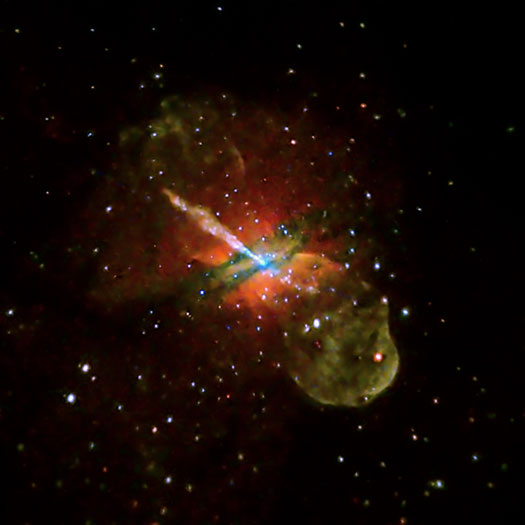
Composite Image
The description above is nothing but a significant piece of the daily work of those who work in the field of Astrophysics. By combining data obtained in different bands, they are trying to reconstruct in the most accurate way the physical processes which take place inside celestial b bodies. Note how each band gives us certain information, and, without them, it is impossible to obtain a complete perspective on what is happenings inside a galaxy.

